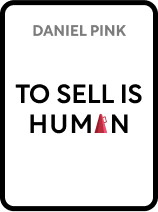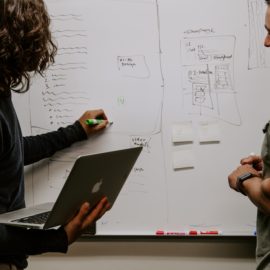

This article is an excerpt from the Shortform book guide to "To Sell Is Human" by Daniel H. Pink. Shortform has the world's best summaries and analyses of books you should be reading.
Like this article? Sign up for a free trial here .
What is the history of sales? Why does Daniel Pink say that we are all salespeople?
In his book To Sell Is Human, Daniel Pink says that all humans are salespeople, whether we like it or not. Pink discusses the transition from traditional sales (or selling sales) to modern sales (or non-selling sales). Pink says that sales aren’t always about making money, it’s often about “moving” others—this can even be in the form of trying to get likes on social media.
Keep reading to learn about the history of sales and how sales has changed over the years.
Unraveling the History of Sales
Hate it or love it, we are all salespeople. Selling is an innate skill we use in every aspect of our lives, and Daniel Pink believes the value of the salesperson has never been higher. To Sell Is Human explains the evolution, significance, and history of sales. It challenges commonly held assumptions by redefining the meaning of sales, re-evaluating the purpose of the salesperson, and showing you how to effectively harness sales skills to create purpose, growth, or “movement” in your life (whether it be for personal or professional gain).
What Are Sales?
Generally, what we think of as sales is actually what might now be called traditional sales. Traditional sales values profits over people, and serves the seller first. The sales industry has since evolved in significant ways, which we’ll discuss later in the chapter. Sales is about “moving” others to give one resource up in exchange for another, whether it be time, attention, money, or something else of value. Selling can mean providing a tangible product or service in exchange for money (this is the type of traditional selling we’re familiar with), but much of what we “sell” or “buy” is immaterial. Let’s call the first type sales selling and the second type non-sales selling.
Sales selling is about selling something for money (the type of sales job that 1 in 9 Americans work in), and non-sales selling is about persuading, influencing, or convincing others to give up a resource of some kind. We sell ourselves on social media in exchange for likes, comments, and other attention. We sell our causes on GoFundMe pages. We sell our bosses on promotions, pitches for ideas, and so on. We sell our partners on cooking dinner or being the one to take the spiders outside. According to a study conducted by Pink, people spend 40% of their time non-sales selling, and the skill is particularly critical for professional success.
How Did We End Up Here?
Our society now reflects the increasing value of non-sales selling. Additionally, the traditional sales philosophy has transformed to reflect the equal information power balance between buyer and seller. The old paradigm allowed sellers to have the power, and profit to be the priority. Now, that power is equal, and service to the buyer is the new priority. These shifts have three origins.
Origin #1: Economic Change and Need for Adaptability
During the heyday of traditional sales, the economy was stable. It prioritized production and consumption. Traditional sales weren’t defined by exchanging all types of resources, but by the exchange of a product for money. Additionally, a stable economy meant that business environments were predictable. As an employer, you didn’t need your business to value adaptable skill sets. As an employee, you knew what was expected of you week to week, and it wasn’t necessary to deviate. These factors allowed sales to become a concentrated skill set. You could be a sales specialist your whole life and never engage with any other specialization.
Indeed, there is little reason to have a sales specialization anymore. The modern economy values movement and adaptability, and it favors a broader range of skills. Everyone is now “selling” in some capacity. This has been embraced by the workforce because these evolved skill sets are creating more profit for businesses. A flexible skillset cuts costs, because you have fewer employees applying a wider range of skills and essentially completing the same volume of tasks as were being completed within the traditional model. With tumultuous economic conditions, a flexible skillset like sales is a major asset.
Origin #2: Rise of Technology and Entrepreneurship
People thought technology would destroy the need for sales by automating the sales process online, but instead, the internet gave the masses access to resources that transformed the landscape of sales. First, the internet derailed traditional sales by shifting the information power balance (discussed further in Chapter 4). Second, it fostered the growth of a new type of sales, creating opportunities for those who otherwise would never engage in “selling.” People who didn’t have the resources to run their own businesses suddenly had access to free information, alternative business platforms, and new ways to build their own customer base. Anyone could become a self-starter, which led to a rise in entrepreneurship. Now, entrepreneurs and startups have become crucial parts of our modern economy.
Additionally, while larger companies can afford to create specialized departments (like sales), smaller businesses often don’t need, or can’t afford, specialized departments. Entrepreneurs must wear many hats, nearly all of which involve moving others (for example, growing a social media following, motivating employees to work efficiently, securing outside funding for the business, and so on). Therefore, the self-starter era has expanded non-sales selling. This has also helped modern sales to become less about selling at all costs, and more about being of service to the clientele (service will be discussed in depth in Part 3). With profit no longer being the priority, salespeople have developed higher motivations for selling (like service).
The new paradigm rewards those who sell with integrity, and for a greater purpose. Now, the expectation is that in the future, the middle class will be composed of, not corporate employees, but self-made dreamers.
Origin #3: Rise of Ed-Med
The changes in the economy created millions of new jobs in a sector encompassing healthcare and education, known as “Ed-Med” (which ranges from nurse practitioners to college test prep providers). Ed-Med is the largest job sector in the modern US economy—more new jobs in this sector have grown in the last decade than all other sectors put together. What does this have to do with sales? To sell is to persuade someone to part with their resources because it will benefit them. Teachers convince students that giving time, energy, and attention to class will benefit them in the long run. Doctors convince patients that doing unpleasant or uncomfortable things (like surgery) will support their long-term health.

———End of Preview———
Like what you just read? Read the rest of the world's best book summary and analysis of Daniel H. Pink's "To Sell Is Human" at Shortform .
Here's what you'll find in our full To Sell Is Human summary :
- Why we are all salespeople in the modern world
- The history, evolution, and significance of sales
- How you can effectively harness sales skills to create purpose, growth, or “movement” in your life






